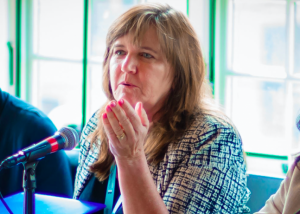
Photo: Ssuaphoto | Dreamstime.com
Cities have turbocharged digital transformation – can they sustain it?
11 April 2022
by Sarah Wray
At a recent Cities Today Institute event in Philadelphia, US digitalisation leaders discussed their efforts to retain new-found agility without creating expectations that they can’t fulfil.
During the height of the pandemic city digitalisation leaders rapidly adapted the smart city plans they were gradually rolling out to saving lives, keeping essential services running and preventing businesses going to the wall.
This saw them turn their tools and teams to facilitating COVID-19 testing, vaccinations and emergency disbursements, and launching new services in weeks and days rather than months and years.
According to some, the crisis accelerated ten years of transformation and proved the value of digital technologies and data to solve real problems. It also imbued a new-found confidence in local government’s ability to innovate despite bureaucracy and limited resources.
As the pandemic evolves and cities look to the longer-term view, they are left asking themselves what their roles and responsibilities look like now, and whether they can truly maintain what they’ve started.
Although they are taking steps to make sure their spending and innovation projects have longevity, some cities are still concerned about living up to new expectations. This is compounded by the influx of American Rescue Plan Act (ARPA) and other federal funds, which cities are working hard to make sure deliver benefits that are financially and practically sustainable.
Where local government begins and ends

One issue is that during the pandemic, a lot of residents started shopping online for the first time. Now they expect the same level of service and speed from their city as they get from companies like Amazon, and could be left disappointed.
Another is the wide range of responsibilities that cities have assumed during the pandemic.
Frank Martz, City Manager for Altamonte Springs, said this now leaves some uncertainties about where the role of local government begins and ends, and what can be expected of them in future crises.
He said the challenge for cities is balancing not only what’s possible in terms of technology capability but also the potential ramifications related to public trust if funding, resources or circumstances change.
Martz urged them to consider “whether as a city you are putting yourself in an unsustainable role. And if you fail at that role, what does it mean to politics and everything else?”
More than money
Many cities used funds from the Coronavirus Aid, Relief, and Economic Security Act (CARES) and now ARPA to support small businesses with grants, expedited processes, and marketing programmes.
These funds are not recurring, though, so for maximum long-term impact, more effort is needed to build long-term resilience.
During the pandemic, Raj Amin, Founding Partner, Teem Ventures, helped convene a small business working group in the township of Montclair, NJ, made up of volunteers with paid ‘day jobs’ who wanted to help their community during a difficult time. With the backing of the mayor but working independently, the group and its three sub-committees brought together small businesses, non-profits and community stakeholders to help keep money circulating locally.

The initial effort was around gathering small business and community requirements and disseminating essential information via a consolidated email list, social media and webinars.
Later, the group moved onto promotional activities, including the launch of a ‘Shop, Eat, Repeat’ campaign, and QR codes around town to drive people to business websites.
The latest phase is focused on a searchable ‘evergreen’ local business directory, which was created using grant funding alongside pro bono resources from Teem Ventures.
More than 200 businesses have signed up for the free self-registration directory. Business owners can include upcoming promotions, connect users to their social media channels and websites, and have their information featured in the ‘Small Business Spotlight’.
Amin said: “This has been a good example of how to unify the town and shown that we can marshal resources at a local level.
“It’s exciting but now that we have this energy overflow, we need to understand ways to sustain this energy and sustain the innovation.”
The group is now looking for new ways they can support the community of Montclair by getting more feedback from local business owners, expanding resident engagement, developing a long-term funding strategy and supporting the creation of an economic development plan.
Building capacity
Cities discovered that some small businesses have limited digital skills – for example, they don’t have a website or use social media. Cash-only companies struggled to access support during the pandemic without the right paperwork.

Addressing these issues is a priority going forward.
The City of South Bend, IN, launched a ‘digital storefront’ grant programme to help local businesses develop or enhance their online presence and capabilities. The city is also focusing on user experience to prevent small businesses being “overwhelmed” by too many resources. This includes rationalising processes between departments and merging as many applications as possible, said Denise Riedl, Chief Innovation Officer at the City of South Bend.
Alongside microgrants and other support, Coral Gables has offered a range of workshops on digital literacy, cybersecurity and e-commerce topics such as making the most of social media, online advertising, and new technologies.
In collaboration with the city and community partners, Chattanooga’s Enterprise Center launched a resiliency checklist to help businesses, non-profits and faith-based organisations better prepare for future crises. The tool includes information to help businesses get the right documentation, relationships and capabilities in place, and to find out about loans and grants.
Streamlined spending
With new confidence across the organisation to try digital tools and fresh funding, there is also a growing push to streamline spending and take a holistic approach.
Ubicquia provides a multi-purpose smart city platform that uses existing streetlights and integrates with third-party vendor solutions such as cameras and licence plate readers.
Ian Aaron, the company’s CEO, said the system and new applications can be deployed “in literally minutes.”

Provision of Wi-Fi for residents is an important use case at the moment as cities work to close the digital divide. The platform offers ‘out of the box’ artificial intelligence applications including public safety video, and counts of traffic, pedestrians and bikes. Ubicquia has also created custom AI deployments to track illegal trash dumping, garbage can usage, and the counts and locations of micromobility devices.
Often cities will start with a handful of use cases and add more over time.
“We’re increasingly seeing multiple use cases across multiple budgets on the same platform,” Aaron said.
He added: “If we change conventional thinking around how to budget, deploy and monitor critical infrastructure, we can improve economics, accelerate projects, and deliver on the promise of real-time cities.”
The City of Dallas is setting up two smart streetlight testbeds that will each test different use cases including public safety and public Wi-Fi. This is being combined with a sidewalk repair and replacement project that incorporates additional streetlights to boost safety.
“We have seen that the use cases are coming from different departments who all want new infrastructure, so the idea is sustainability for the city by looking at a single platform,” said William Zielinski, Chief Information Officer, City of Dallas.
There was a consensus among leaders that this trend for multifunctional platforms also requires underlying policies to be in place for data-gathering systems, and many are now following in the footsteps of cities such as Oakland to develop oversight boards and guidelines.
Measure
Performance metrics are an important way for cities to evaluate their investment and inform future decisions.

Jeanne Holm, Deputy Mayor for Budget and Innovation in Los Angeles, said the latest budget was the “most progressive” in the city’s history, providing US$1 billion for homelessness and US$1 billion for equity and justice. It also included funding for the largest guaranteed income pilot in the US to date, as well as for participatory budgeting, digital inclusion and broadband.
LA also launched a programme that will divert some 911 calls related to homelessness and other non-violent issues away from law enforcement to trained, unarmed mental health professionals.
Holm said her department is working to make sure everything that is funded has a performance metric that department managers can report against and that aligns with the mayor’s priorities.
As cities use their ARPA dollars, many are also setting up dashboards for the first time to track how money is allocated, spent and the ultimate outcomes.
Scaling data
The pandemic has highlighted the power of data to help cities solve challenges, from understanding COVID hotspots and recovery trends to getting support to those who need it most.
But some cities still struggle to persuade certain departments to share their data, and others are concerned about the ability to sustain data efforts when priorities shift.
Nitin Agarwal, Worldwide Lead for Smart Cities, Hewlett Packard Enterprise, highlights the growing importance of moving away from a siloed data approach towards a central platform to provide integrated analytics and deliver more value to data stakeholders early. This is becoming more pressing as cities upgrade their infrastructure and add more technology.
“With a central platform you will get all the data and you are able to not only visualise data on dashboards, but you’re able to monitor, manage and control — particularly IoT applications,” he said.
“Once you have this, all the city applications such as smart parking, smart transport, smart waste, etc. can be built on top.”
The big question
The current moment with historic funds flowing into US cities presents an opportunity to not only upgrade infrastructure now but to improve communities for the long-term and transform city practices and culture in the process, through a holistic strategy underpinned by policies and an outcome-focused approach.
When they receive proposals for innovation projects, one of the first questions digitalisation leaders are now asking is: “How are you going to sustain it?”










